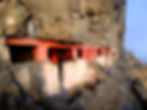
Gorakhgad
Grade : Moderate
Region : Murbad
Base village : Dehri
Landmark : Murbad
Number of Routes : 1
Highest Altitude : 2130 Feet (650m)
Trek Duration : 3 hours to ascend, 2.5 hours to descend
Surrounding Peaks : Ahupe Ghat, Siddhgad and Macchindragad
Ideal Season : November to February (Night Trek)
Major Attarction :
Thrilling Rock Cut Stairs Climb, Caves and Temple near Top, View of Ahupe Ghat, Siddhgad, Macchindragad.
Water Sources :
Two cisterns can be seen just after the entrance. There are in total fourteen cisterns on the fort, however, only the three tanks near to the cave have potable water. However water is not potable at times hence it is recommended to carry water from Base Village itself.
Special thing about structure/route :
There is a thrilling climb towards the pinnacle with cut rocks.
Other Special thing :
On the route from siddhagad to gorakgad, one can find one waterfall. During monsoon season, one can see the view of the many waterfalls and a large range of wildflowers.
History Info :
Ancient Name & Meaning (if any) :
Gorakgad, The fort is named after saint Goraknath, who used to perform penance here.
Era :
It was built in Satavahan period of India's history (~5000 years ago). It was used in the era of Shivaji Maharaj, mainly as a stopover point from Junnar via Naneghat. The fort was initially used to keep prisoners during the Nizamshahi rule. It was then ruled by the More clan of the Javli region.
Brief War History :
It was had strategic importance during the reign of Shahaji Raje. However, no major battle is recorded to have taken place here. It was used in Shivaji Maharaj era to patrol the nearby region and was used as a stopover station during the journey to Junnar via Naneghat.




